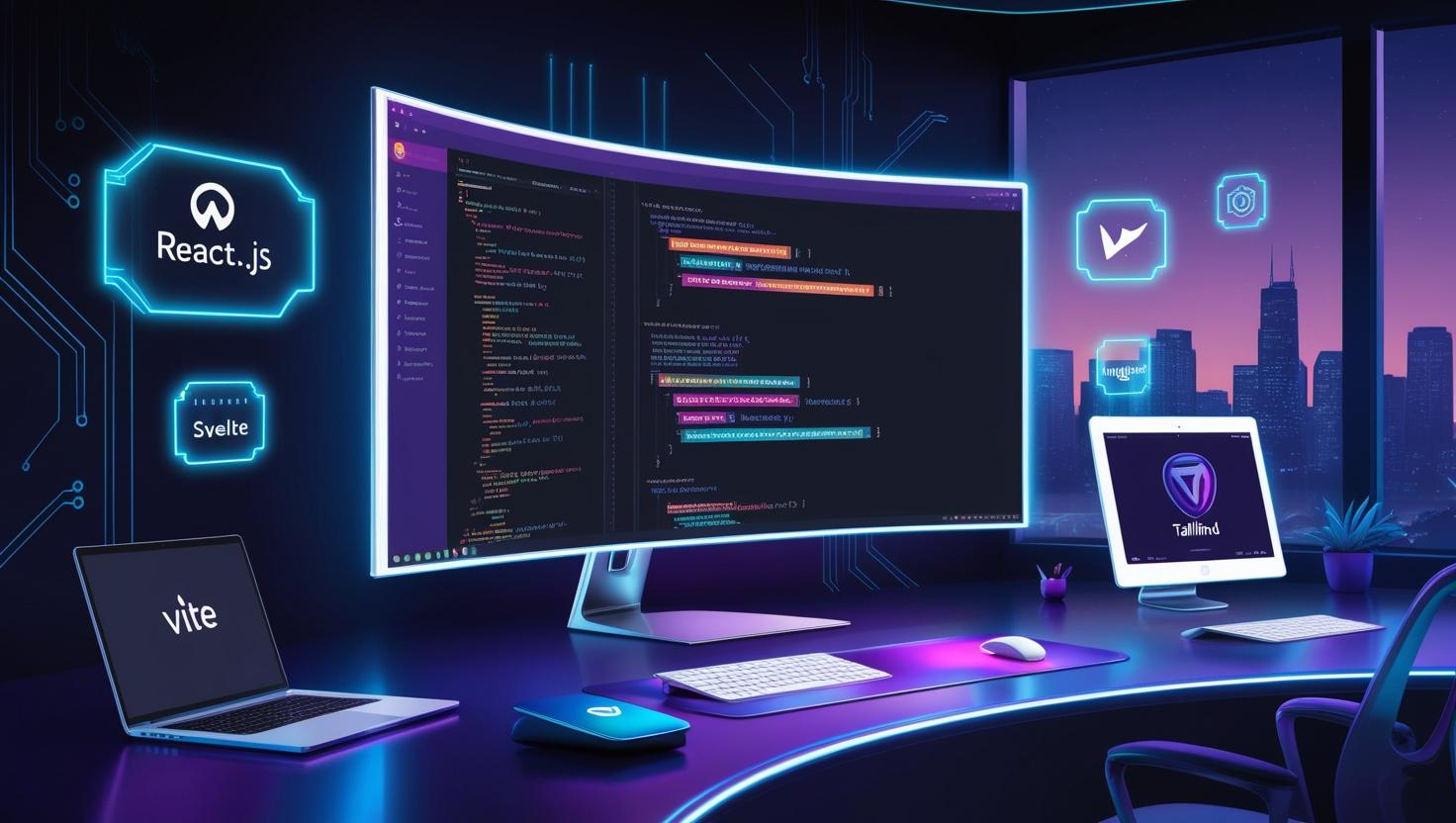In 2025, frontend development is evolving rapidly with powerful frameworks, libraries, and tools shaping user experiences. Discover the top 10 frontend technology stacks driving innovation and performance.

What Makes a Great Frontend Technology Stack?
A frontend technology stack is a combination of tools, frameworks, and libraries used to build the user-facing layer of web applications. In 2025, the best stacks prioritize performance, scalability, developer experience, and alignment with business goals. Key considerations include:
Performance: Fast load times and smooth interactions (e.g., Core Web Vitals metrics).
Ecosystem: Rich libraries, community support, and integrations.
Scalability: Ability to handle complex, high-traffic applications.
Developer Productivity: Tools that streamline workflows and reduce boilerplate.
With these criteria in mind, let’s explore the top 10 frontend technology stacks for 2025, based on adoption, features, and industry trends.
Top 10 Frontend Technology Stacks for 2025
React + Next.js + TypeScript
Why it’s top: React remains the king of frontend libraries, powering 42% of professional developers’ projects (Stack Overflow 2024). Next.js enhances React with server-side rendering (SSR) and static site generation (SSG), improving SEO and performance. TypeScript adds type safety, reducing bugs in large-scale apps.
Use Case: E-commerce platforms like Shopify use this stack for fast, dynamic storefronts.
Pros: Robust ecosystem, excellent performance, strong community.
Cons: Steep learning curve for SSR and TypeScript.Vue.js + Nuxt.js + Vite
Why it shines: Vue.js is loved for its simplicity and flexibility, used by 18% of developers (State of JS 2024). Nuxt.js, Vue’s answer to Next.js, simplifies SSR and SSG. Vite, a lightning-fast build tool, boosts developer productivity with near-instant hot module replacement (HMR).
Use Case: Rapid prototyping for startups like GitLab’s frontend.
Pros: Lightweight, beginner-friendly, fast builds.
Cons: Smaller ecosystem than React.Angular + RxJS + Tailwind CSS
Why it’s relevant: Angular’s full-fledged framework suits enterprise applications, with 12% adoption (JetBrains 2024). RxJS enables reactive programming for complex data flows, and Tailwind CSS accelerates UI styling with utility-first classes.
Use Case: Large-scale dashboards for financial institutions like PayPal.
Pros: Comprehensive framework, built-in tools, scalable.
Cons: Verbose syntax, longer onboarding.Svelte + SvelteKit + PostCSS
Why it’s rising: Svelte shifts work to compile time, producing highly optimized vanilla JavaScript. SvelteKit, its full-stack framework, supports SSR and SSG. PostCSS enhances styling with modern CSS features. Svelte’s adoption grew 25% year-over-year (State of JS 2024).
Use Case: Interactive media sites like The New York Times’ visualizations.
Pros: No runtime overhead, intuitive syntax, fast performance.
Cons: Smaller community, fewer third-party libraries.React + Remix + Styled-Components
Why it’s powerful: Remix, a newer React framework, focuses on web fundamentals like progressive enhancement and nested routing, gaining traction with 8% adoption (State of JS 2024). Styled-Components enables CSS-in-JS for reusable, scoped styles.
Use Case: Dynamic SaaS platforms like Notion.
Pros: Modern routing, great developer experience, flexible styling.
Cons: Remix is less mature than Next.js.SolidJS + SolidStart + Emotion
Why it’s emerging: SolidJS rivals React with fine-grained reactivity and no virtual DOM, offering superior performance. SolidStart, its meta-framework, supports SSR and SSG. Emotion provides CSS-in-JS for dynamic styling.
Use Case: High-performance apps like real-time collaboration tools.
Pros: Blazing fast, lightweight, React-like syntax.
Cons: Early-stage ecosystem, limited enterprise adoption.Preact + Vite + Chakra UI
Why it’s efficient: Preact, a lightweight React alternative (3KB vs. React’s 40KB), pairs well with Vite for fast builds. Chakra UI offers accessible, customizable components for rapid UI development.
Use Case: Mobile-first apps with constrained resources, like Uber’s lite version.
Pros: Tiny footprint, fast prototyping, accessible components.
Cons: Limited features compared to React.Astro + React + Tailwind CSS
Why it’s unique: Astro’s island architecture delivers static sites with dynamic “islands” of interactivity, reducing JavaScript overhead. It integrates seamlessly with React and Tailwind CSS for styling. Astro’s usage doubled in 2024 (State of JS 2024).
Use Case: Content-heavy sites like tech blogs or portfolios.
Pros: Exceptional performance, flexible framework integration.
Cons: Less suited for highly dynamic apps.Qwik + Qwik City + CSS Modules
Why it’s innovative: Qwik optimizes for instant loading by deferring JavaScript execution until needed, achieving near-0ms startup times. Qwik City, its meta-framework, supports SSR and SSG. CSS Modules ensure scoped, maintainable styles.
Use Case: Performance-critical apps like online gaming platforms.
Pros: Unmatched startup speed, scalable architecture.
Cons: Newer framework, smaller community.Ember.js + Glimmer + Bootstrap
Why it’s enduring: Ember.js, a veteran framework, offers stability for long-term projects with its “convention over configuration” philosophy. Glimmer, its rendering engine, boosts performance. Bootstrap provides rapid, responsive styling.
Use Case: Legacy enterprise apps like LinkedIn’s internal tools.
Pros: Mature ecosystem, strong conventions, reliable.
Cons: Slower innovation, declining popularity.
Choosing the Right Stack: A Decision Framework
Selecting a frontend stack depends on project needs and team expertise. Consider:
Project Scale: Small startups may prefer Vue.js or Svelte for speed, while enterprises lean toward Angular or React.
Performance Goals: Qwik or Astro excel for speed-critical apps.
Team Skills: React-based stacks are easier for JavaScript-heavy teams.
Budget: Open-source tools like Tailwind CSS reduce costs compared to premium UI libraries.
For example, a media company building a blog might choose Astro + React for performance, while a fintech firm might opt for Angular + RxJS for robustness.
Challenges and Trends in Frontend Development
While these stacks empower developers, challenges persist:
Learning Curve: Frameworks like Next.js and Angular require time to master SSR or reactive programming.
Tool Fatigue: The rapid pace of innovation (e.g., Vite, Qwik) can overwhelm teams.
Performance Pressure: Google’s Core Web Vitals push developers to optimize for speed and accessibility.
Trends to watch include AI-driven UI design (e.g., GitHub Copilot for code), WebAssembly for near-native performance, and growing adoption of TypeScript (used by 78% of developers, per JetBrains 2024).